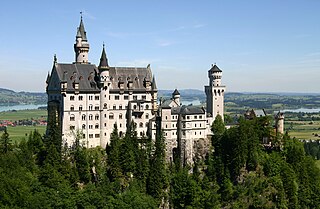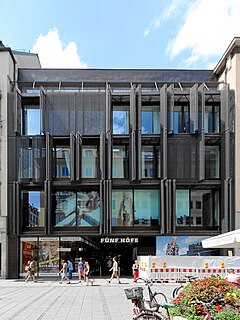

The Kabinettsgarten is a small courtyard on the eastern side of the royal residence in Munich. The Kabinettsgarten adjoins the Allerheiligen-Hofkirche. [1]


The Kabinettsgarten is a small courtyard on the eastern side of the royal residence in Munich. The Kabinettsgarten adjoins the Allerheiligen-Hofkirche. [1]
In the mid-19th century, the courtyard was built on the eastern edge of the residence, which was surrounded by a wall and could only be entered through a narrow opening. Originally a fountain stood in the middle of the lawn, which was bordered by four linden trees along the courtyard wall and a wooden pergola. In the 20th century, the garden became overgrown and was used as a vegetable garden or as a chicken farm. [1]
In 2002, the Bavarian Ministry of Finance decided that the garden be redesigned by the landscape architect Peter Kluska. The construction lasted from October 2002 to June 2003, [2] and its costs are stated to be 437,000 Euros.
The small garden of 1000 m2 [3] fills a niche in the building gable of the residence. It is accessible to the general public from Marstallplatz. In addition, a newly created outside staircase leads from the inside of the residence to the garden. It can be reached from events at the Allerheiligen-Hofkirche, the foyer of the Cuvilliés Theatre and the Brunnenhof. [4]
Through the narrow entrance, visitors are led to a small square with a sculpture by the sculptor Fritz Koenig. The subsequent middle ground is bounded by shallow water surfaces with geometric mosaics, which are in turn edged by narrow strips of grass. At the opposite end is again a small square with a round, low fountain lined with four plane trees whose crowns are cut to grow together into a common roof. [5] At the edges of the garden are side paths, so you can walk around the entire area. All around are benches where visitors can settle.
Floor slabs, steps and stone blocks are of very light limestone and loosen up the warm earth tones of the facades. The shallow pools have a dark base made of orthogneiss, which are divided by white stripes of glass stones. In them, a regular pattern of red and green glass surfaces is incorporated. Water and light give movement to the patterns.
The garden was honored at the Deutscher Landschaftsarchitekturpreis 2005 (German Landscape Architecture Award) [6] and was nominated for the DBA Prize 2006. It is described as a "little gem" that conveys a "serene atmosphere" and "enchanting mood."


Munich is the capital and most populous city of Bavaria. With a population of 1,558,395 inhabitants as of 31 July 2020, it is the third-largest city in Germany, after Berlin and Hamburg, and thus the largest which does not constitute its own state, as well as the 11th-largest city in the European Union. The city's metropolitan region is home to 6 million people.

Neuschwanstein Castle is a 19th-century historicist palace on a rugged hill above the village of Hohenschwangau near Füssen in southwest Bavaria, Germany. The palace was commissioned by King Ludwig II of Bavaria as a retreat and in honour of Richard Wagner. Ludwig chose to pay for the palace out of his personal fortune and by means of extensive borrowing, rather than Bavarian public funds. Construction began in 1869, but was never fully completed.

The Residenz in central Munich is the former royal palace of the Wittelsbach monarchs of Bavaria. The Residenz is the largest city palace in Germany and is today open to visitors for its architecture, room decorations, and displays from the former royal collections.

Leo von Klenze was a German neoclassicist architect, painter and writer. Court architect of Bavarian King Ludwig I, Leo von Klenze was one of the most prominent representatives of Greek revival style.

Eishockeyclub Red Bull München is a professional ice hockey team based in Munich, Germany. The club is a member of the Deutsche Eishockey Liga (DEL), the highest level of play in professional German ice hockey.

This article contains the population growth of Munich via tables and graphs.

The New Town Hall is a town hall at the northern part of Marienplatz in Munich, Bavaria, Germany. It hosts the city government including the city council, offices of the mayors and a small portion of the administration. In 1874 the municipality had left the Old Town Hall for its new domicile.

The Allerheiligen-Hofkirche is a church in the Munich Residenz designed by Leo von Klenze and built between 1826 and 1837. The church was badly damaged from bombing during World War II and for decades remained a ruin before undergoing partial restoration and secularization. It is now used for concerts and events.

Valentina Babor is a German classical pianist. She began performing before audiences and winning youth competitions as a child. At 12, she was accepted by Karl-Heinz Kämmerling at the Mozarteum, where she became part of the university's "Initiative Hochbegabten-Förderung", a program for highly gifted students. In 2009, barely an adult, she played Rachmaninoff's Piano Concerto in C minor in concert. She continues to perform internationally.

The Shopping mall Fünf Höfe in the center of Munich was created from 1998 to 2003 after the coring of a HypoVereinsbank building complex. In 2004, the Fünf Höfe was sold to DIFA and since then the official name has been CityQuartier Fünf Höfe.

Old Botanical garden is located in Maxvorstadt, Munich, Bavaria, Germany.

The Odeon is a former concert hall in the Odeonsplatz in Munich, Bavaria, Germany, which is named after it. Built in the early 19th century to a design by Leo von Klenze and forming a counterpoint to the externally identical Palais Leuchtenberg, it was rebuilt after being almost totally destroyed in World War II and now houses the Bavarian Ministry of the Interior.
The following is a timeline of the history of the city of Munich, Germany.

The following outline is provided as an overview of and topical guide to Munich:

Angertorstraße 3 is an apartment building in Munich, Germany that is a registered Bavarian historical monument.

The building at Blumenstraße 29 in Munich is a guest and rental house. It is registered as a historical monument building in the Bavarian List of Monuments.

The Diana Temple in the Munich Hofgarten, the garden of the Munich Residenz, is a twelve-sided gazebo from the Renaissance period with eight open and four closed round arcades. It is the crossing point of the main and diagonal axes of the Hofgarten.

The Munich Old Town is part of the Bavarian capital Munich and has belonged to the city the longest, even if some places which are meanwhile districts of Munich, were mentioned long before Munich's documents spoke of the Old Town. The Old Town forms together with the district Lehel, the municipality No. 1 Altstadt-Lehel. The entire area of the Old Town is listed as both a historical ensemble as well as a historical monument listed in the Bavarian historical monument list.

The Nymphenburg Palace Park ranks among the finest and most important examples of garden design in Germany. In combination with the palace buildings, the Grand circle entrance structures and the expansive park landscape form the ensemble of the Nymphenburg Summer Residence of Bavarian dukes and kings, located in the modern Munich Neuhausen-Nymphenburg borough. The site is a Listed Monument, a Protected Landscape and to a great extent a Natura2000 area.

Volker Staab is a German architect.
| Wikimedia Commons has media related to Kabinettsgarten . |